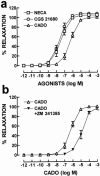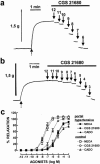Adenosine A(2A) receptors in portal hypertension: their role in the abnormal response to adenosine of the cranial mesenteric artery in rabbits
- PMID: 11877342
- PMCID: PMC1573239
- DOI: 10.1038/sj.bjp.0704575
Adenosine A(2A) receptors in portal hypertension: their role in the abnormal response to adenosine of the cranial mesenteric artery in rabbits
Abstract
1. Adenosine is a regulator of mesenteric vasodilation involved in auto-regulation and post-prandial hyperemia, but the adenosine receptor subtype involved in this relaxant effect is poorly characterized. We have now pharmacologically characterized this receptor in rabbit mesenteric arteries and investigated how this adenosine receptor response changes in portal hypertensive animals since the adenosine response is decreased. 2. The closest non-metabolisable adenosine analogue, 2-chloroadenosine (CADO), the mixed A(1)/A(2) receptor agonist, 5'-ethylcarboxamidoadenosine (NECA), and the selective A(2A) receptor agonist, 2-[4-(2-p-carbonyethyl)phenylamino]-5'-N-ethylcarboxamidoadenosine (CGS 21680) (1 pM -- 1 mM) relaxed noradrenaline pre-contracted arteries with a rank order of potency of CGS 21680 (EC(50)=20 nM) > or = NECA (60 nM)>>CADO (640 nM). 3. The selective A(2A) receptor antagonist, 4-(2-[7-amino-2-(2-furyl)-[1,2,4]-triazolo[2,3-a][1,3,5]-triazin-5-ylamino]ethyl)phenol (ZM 241385, 100 nM), shifted to the right the CADO concentration-response curve. 4. In portal hypertensive animals, there was mainly a decreased potency but also a decreased efficacy of all tested adenosine agonists compared to normal animals. Concomitantly, there was a decreased adenosine plasma level and a decreased binding density of [(3)H]-CGS 21680 and [(3)H]-ZM 241385 to mesenteric artery membranes from portal hypertensive compared to normal rabbits. 5. These results indicate that A(2A) receptor activation is required for the adenosine-induced mesenteric relaxation and that the decreased density of A(2A) receptors may contribute to the decreased relaxation induced by adenosine of mesenteric arteries in portal hypertensive animals.
Figures



Similar articles
-
Activation of two sites by adenosine receptor agonists to cause relaxation in rat isolated mesenteric artery.Br J Pharmacol. 1997 Dec;122(7):1509-15. doi: 10.1038/sj.bjp.0701524. Br J Pharmacol. 1997. PMID: 9421303 Free PMC article.
-
Relaxation of the mouse isolated aorta and carotid artery in response to adenosine analogues in genetically-modified mice lacking the adenosine A(2A) receptor.Naunyn Schmiedebergs Arch Pharmacol. 2002 Aug;366(2):127-33. doi: 10.1007/s00210-002-0581-7. Epub 2002 Jun 6. Naunyn Schmiedebergs Arch Pharmacol. 2002. PMID: 12122499
-
Prolonged exposure to 5'-N-ethylcarboxamidoadenosine (NECA) does not affect the adenosine A2A-mediated vasodilation in porcine coronary arteries.Pharmacol Res. 1997 Feb;35(2):123-8. doi: 10.1006/phrs.1996.0125. Pharmacol Res. 1997. PMID: 9175581
-
Medicinal chemistry of adenosine A2A receptor agonists.Curr Top Med Chem. 2003;3(4):387-401. doi: 10.2174/1568026033392282. Curr Top Med Chem. 2003. PMID: 12570757 Review.
-
Hypertension due to chronic blockade of P1-purinoceptors.J Auton Pharmacol. 1996 Dec;16(6):367-70. doi: 10.1111/j.1474-8673.1996.tb00055.x. J Auton Pharmacol. 1996. PMID: 9131418 Review.
Cited by
-
Purinergic receptors in the splanchnic circulation.Purinergic Signal. 2008 Sep;4(3):267-85. doi: 10.1007/s11302-008-9096-0. Epub 2008 Apr 29. Purinergic Signal. 2008. PMID: 18443747 Free PMC article.
-
Adenosine Receptors Influence Hypertension in Dahl Salt-Sensitive Rats: Dependence on Receptor Subtype, Salt Diet, and Sex.Hypertension. 2018 Aug;72(2):511-521. doi: 10.1161/HYPERTENSIONAHA.117.10765. Epub 2018 Jun 25. Hypertension. 2018. PMID: 29941515 Free PMC article.
-
Functional changes in vascular reactivity to adenosine receptor activation in type I diabetic mice.Eur J Pharmacol. 2018 Feb 5;820:191-197. doi: 10.1016/j.ejphar.2017.12.034. Epub 2017 Dec 18. Eur J Pharmacol. 2018. PMID: 29269016 Free PMC article.
-
Functional and RNA expression profile of adenosine receptor subtypes in mouse mesenteric arteries.J Cardiovasc Pharmacol. 2013 Jan;61(1):70-6. doi: 10.1097/FJC.0b013e318278575e. J Cardiovasc Pharmacol. 2013. PMID: 23288107 Free PMC article.
-
Impaired function of prejunctional adenosine A1 receptors expressed by perivascular sympathetic nerves in DOCA-salt hypertensive rats.J Pharmacol Exp Ther. 2013 Apr;345(1):32-40. doi: 10.1124/jpet.112.199612. Epub 2013 Feb 8. J Pharmacol Exp Ther. 2013. PMID: 23397055 Free PMC article.
References
-
- ATUCHA N.M., CLARA ORTIZ M., FORTEPIANI L.A., RUIZ F.M., MARTINEZ C., GARCIA-ESTAN A. Role of cyclic guanosine monophosphate and K+ channels as mediators of the mesenteric vascular hyporesponsiveness in portal hypertensive rats. Hepatology. 1998;27:900–905. - PubMed
-
- BALWIERCZAK J.L., SHARIF R., KRULAN C.M., FIELD F.P., WEISS G.B., MILLER M.J.S. Comparative effects of a selective adenosine A2 receptor agonist, CGS 21680, and nitroprusside in vascular smooth muscle. Eur. J. Pharmacol. 1991;196:117–123. - PubMed
-
- BELARDINELLI L., SHRYOCK J.C., SNOWDY S., ZHANG Y., MONOPOLI A., LOZZA G., ONGINI E., OLSSON R.A., DENNIS D.M. The A2A adenosine receptor mediates coronary vasodilation. J. Pharmacol. Exp. Ther. 1998;284:1066–1073. - PubMed
-
- BOSCH J., NAVASA M., GARCIA PAGÁN J.C., DELACY A.M., RODÉS J. Portal hypertension. Med. Clin. North Am. 1989;73:931–953. - PubMed
-
- CHOJKIER M., GROSZMANN R.J. Measurement of portal-systemic shunting in the rat by using gamma-labeled microspheres. Am. J. Physiol. 1981;240:G371–G375. - PubMed
Publication types
MeSH terms
Substances
LinkOut - more resources
Full Text Sources

